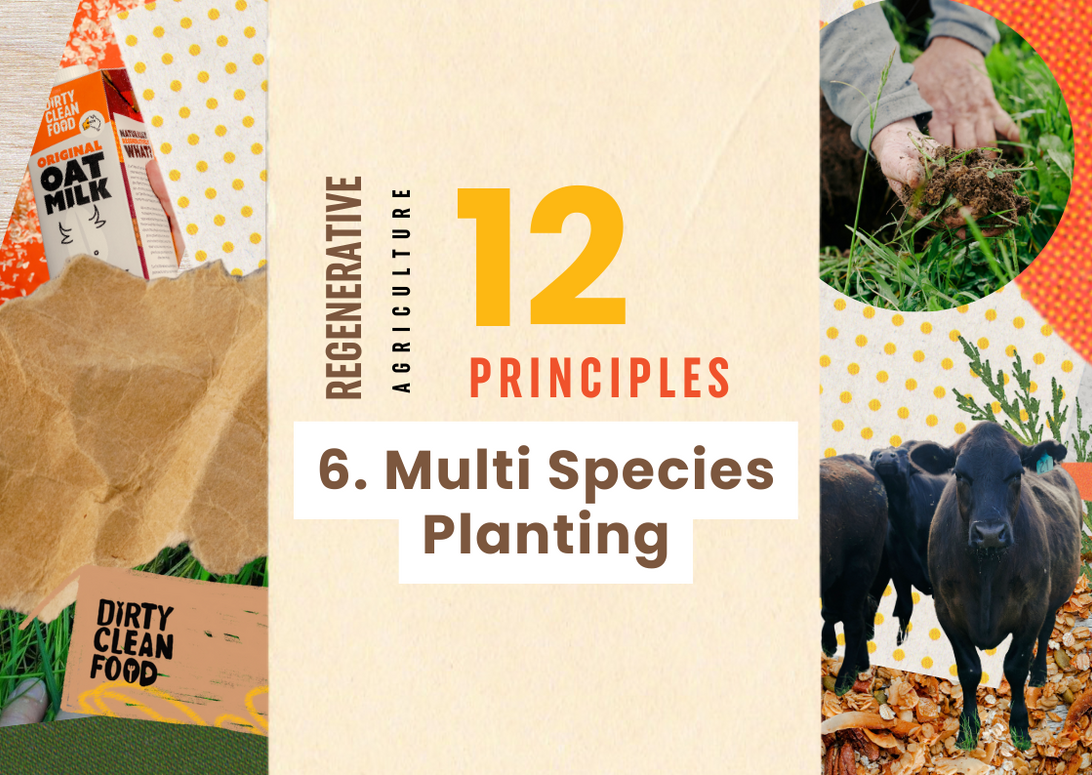
Regen Ag #6- Multi Species Planting
|
Time to read 3 min
|
Time to read 3 min
Welcome to our 12 Principles of Regenerative Agriculture series- where we define "regen ag" and show you how regenerative farming changes the planet, the system, and our food.
Our #6 Principle, multi species plantings, is an extremely beneficial practice that deserved it's own spot on our 12 Principles.
Conventional monoculture cropping systems have dominated our agricultural landscapes for decades and tend to be characterized by vast expanses of a single plant species. However, the detrimental impacts of monocropping on soil health, biodiversity, and ecosystem resilience are increasingly apparent. In response, regenerative farmers and agronomists are turning to alternative approaches, one of the most promising being multi-species cropping or multi-species pastures.
Multi-species cropping involves planting a diverse array of plant species in the same paddock or pasture. Instead of a single crop dominating the landscape, farmers cultivate a mix of species that complement each other both in terms of their growth habits and ecological functions. This approach mimics the natural diversity found in ecosystems, harnessing the inherent resilience and productivity of diverse plant communities.
One of the key principles behind multi-species cropping is the concept of ecological synergy. Different plant species have unique nutrient requirements and growth patterns. By intercropping complementary species, farmers can optimize resource utilization, reduce competition for nutrients, and enhance overall productivity. For example, leguminous plants such as peas and beans have the ability to fix atmospheric nitrogen, enriching the soil and benefiting neighbouring crops that require nitrogen for growth.
Beyond soil health, multi-species cropping also offers numerous benefits for pest and disease management. Monoculture systems are highly susceptible to pest outbreaks and disease epidemics, as pathogens can easily spread throughout a uniform crop. In contrast, multi-species cropping disrupts pest and disease cycles by creating a less hospitable environment for pests and promoting natural predators that keep pest populations in check. This reduces the need for synthetic pesticides and fosters a more balanced agroecosystem.
The photo below is an example of legume crops fixing atmospheric nitrogen! Steve Ford’s ‘beanola’ crop is a mix of faba beans and canola growing together. He wanted to experiment planting these legumes in rotation with his oats crop and pasture phases.
This particular crop was harvested as a cash crop, meaning that both the canola and faba beans were harvested to be sold. The seed of these crops was run through a seed cleaner to separate out the large beans from the tiny canola seeds.
In the 3rd photo, you can see the nodes on the roots of the faba beans – the little white / pink nodules – that are a sign the plant is actively fixing nitrogen.
This multi species crop at Steve’s farm was a cover crop, meaning it was grown and grazed off for sheep feed in between oat and canola crop rotations. It was a mix of oats, vetch, cereal rye, peas, clover and faba beans. This crop was inoculated with biological fertilizer, then left to grow for the season, before being grazed at the end of the season by Steve’s sheep. This crop helped to build the soil for next year’s oats, and provided great feed at the end of the season for the ewes and lambs.
‘Regenerative agriculture is an ecological approach to farming that allows landscapes to renew themselves.’




